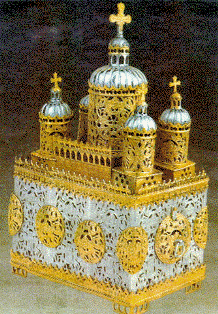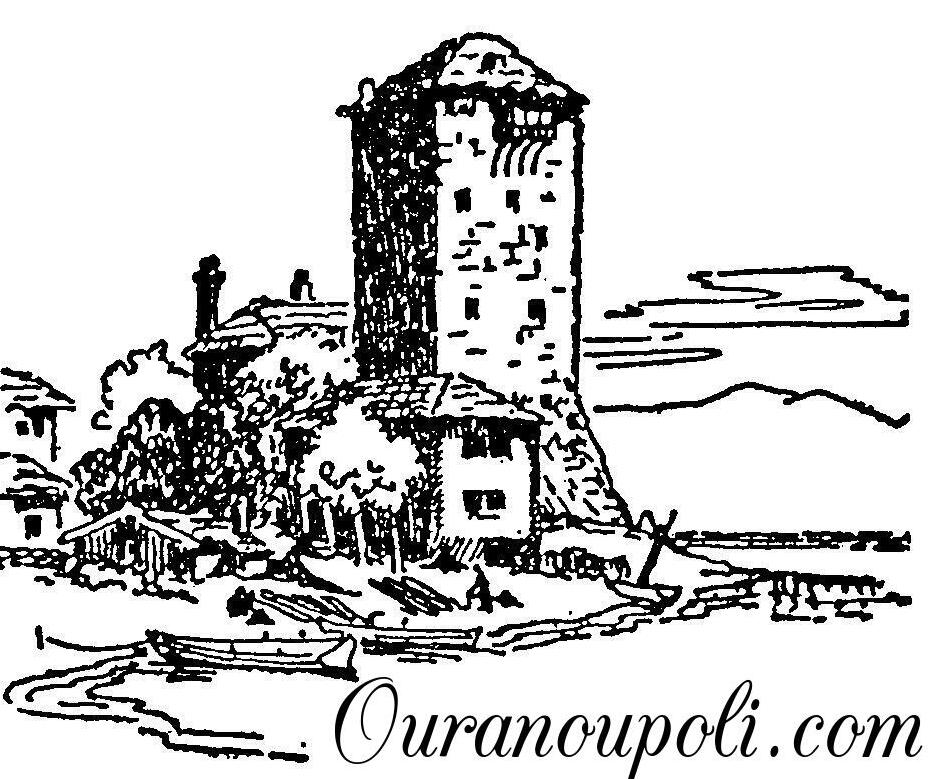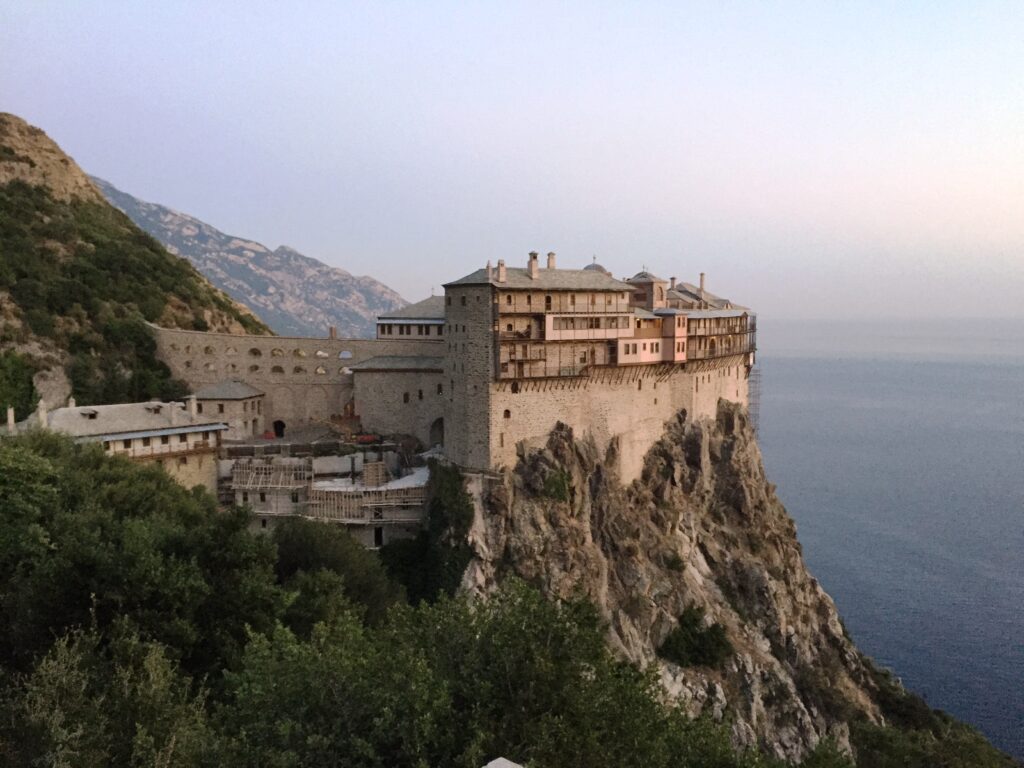
Mount Athos or Agion Oros, as it is locally known, is the oldest surviving monastic community in the world. It dates back more than a thousand years, to Byzantine times. It is a unique monastic republic, which, although part of Greece, it is governed by its own local administration.
It occupies the best part of the Athos peninsula in Halkidiki. It consists of a range which runs south-east for thirty miles from Xerxes’ Canal, where Xerxes the Persian King cut a canal across the peninsula for his ships to pass. A rugged, sea-battered peninsula 56 kilometers long. Two kilometers wide at the canal, it broadens to eight, with a long back-bone rising into peaks of roughly five hundred, six hundred, six hundred and fifty, eight hundred and fifty and a thousand meters. Finally the imposing marble summit of Athos itself, 2,039 meters high, 6,670 feet of grey-white crystalline limestone. Its snow-capped peak is usually crowned by white clouds, an awesome sight to see.
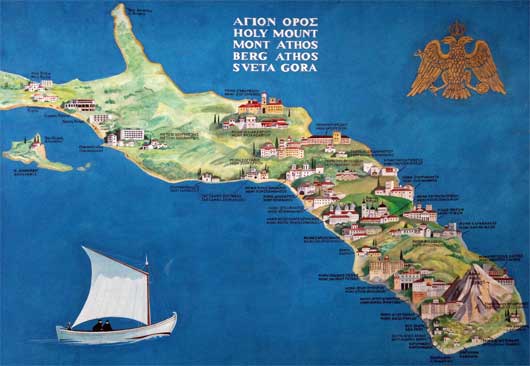
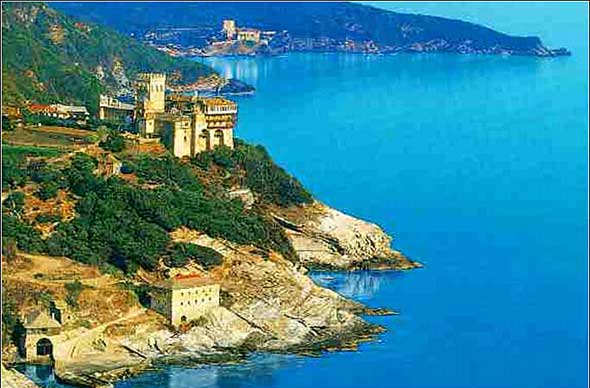
Because of its isolation Mount Athos has remained one of the most unspoiled parts of Greece. The landscape is stunning and wild, with small green valleys and gorges, well wooded peaks interspersed with precipitous ravines and an inaccessible coastline. Small streams of crystal clear water run free under the deep shade of the chestnut trees. Here and there in this wilderness are the fortified walls of the monasteries, with small vegetable plots around them, encircled by a silver-green sea of the olive groves. Hidden among the greenery and the impassable gorges, perched in the most unexpected positions is the white speckle of a little hut were a hermit spends his days in solitude and contemplation.
It is a land where myth is entwined with history, miracles mingle with reality. Savage mountain scenery reflecting on the dark blue sea create that essential framework of isolation in a peaceful, solitary world, chosen by the hermits for their monastic state.
History
According to the legend Panagia, the Virgin Mary and Mother of God, was sailing accompanied by St John the Evangelist on her way from Joppa to Cyprus to visit Lazarus. When the ship was blown out of course to then pagan Athos it was forced to drop anchor near the port of Klement, close to the present monastery of Iviron. The Virgin walked ashore and, overwhelmed by the wonderful and wild natural beauty of the mountain she blessed it and asked her Son for it to be her garden. A voice was heard; “let this place be your inheritance and your garden, a paradise and a haven of salvation for those seeking to be saved”. Since that moment the mountain was consecrated as the garden of the Mother of God and is out of bounds to any other women.
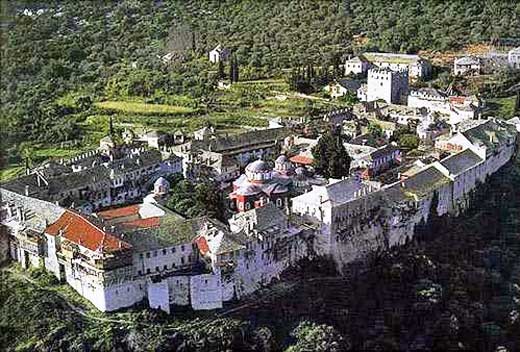
The history and fortunes of Mount Athos were turbulent and varied through the centuries. Grandeur alternated with decline, prosperity was followed by poverty, destruction with rebuilding. It is certainly true that Mount Athos was populated in pre-Christian days. Herodotus, the ancient Greek historian, mentions a number of cities there and an oracle of Apollo. It is also true that there were hermits on Mount Athos in the 7th century AD. However, the first historical reference of the Mountain as a monastic centre is in a passage stating that monks from Athos took part in the Council of 843 AD, convened by Theodora the Byzantine Empress, to discuss the restoration of the Holy Icons. In 885 the Emperor Basilios the Ist issued a Chrysobullo (imperial edict) officially recognising Athos as a territory belonging exclusively to monks. It declared that only religious men should live there and all other laymen, shepherds etc, were forbidden to enter the “Garden of the Virgin”.

The first historically confirmed hermits were Peter the Athoniatis and Euthymios of Salonica, both of them dating around 840 AD, both of them very influential in the history of Mount Athos. As tradition would have it Peter the Athoniatis was also sailing past Mount Athos when he found his ship miraculously rooted in the sea off Karavostasi (the Bay of the Standing Ship). Immediately he realized that this was a heavenly sign that his journey was over. He promptly climbed up the savage ravine and into a cave, watched in astonishment by the ship’s crew, who were able to sail forthwith. That was the start of fifty years of solitude and canonisation after his death. When a hunter discovered him nearing the end of his life he was so moved by the hermits sanctity he vowed to follow the ascetic life himself. However, when the converted hunter arrived the following year with a little band of followers he found the future saint already dead and his bones strewn on the cave floor.
The bones were reverently collected and kept by the monks of Klementos, a monastery which stood where Iviron stands today. The monk’s story implies that in 840 AD, when Peter the Athonite arrived the mountain was largely uninhabited, but by the time of his death 50 years later the monastery of Klementos was already built.
The young Euthymios had arrived at the mountain by then. He was born near Ankara in 823 and, after leaving a wife and child he took up the life of the hermit in Mount Athos. In 862 he became head of a community of monks and was able to establish numerous hermit settlements throughout the Mountain and Halkidiki, during the second half of the ninth century. A certain John Kolovos also arrived to Mount Athos and together with Euthymios founded the monastery of Kolovou in 875. One account places it near the village of Ierissos, well outside the present day border. Others place it at Megali Vigla, inside Mount Athos. What is certain is that Kolovou lasted for a whole century, and in the last quarter of the tenth century it was taken over by the Great Lavra, which was founded by Athanasios in 963.
Great Lavra is the leading monastery on the Mountain today. It was founded by Athanasios, who although from a very rich family, entered the Mountain as a peasant, intending to loose his identity. Up to that time the few monks who had already settled there were living either in communities or as hermits, under a leader called who they called Protos (The First). In 972 the seat of Protos was transferred to Messi (the middle of the mountain) which subsequently changed its name to Karyes and became the administrative centre of Mount Athos. Athanasios was discovered by his childhood friend Nikiphoros Phokas, soon to become a Byzantine Emperor, who offered him the funds to build a great monastery. Great Lavra was built in 963 in the very place where Athanasios spent his initiation and was populated by eighty monks. Gradually more monasteries on the Great Lavra model came into being and the hermit system gave way to the monastic.
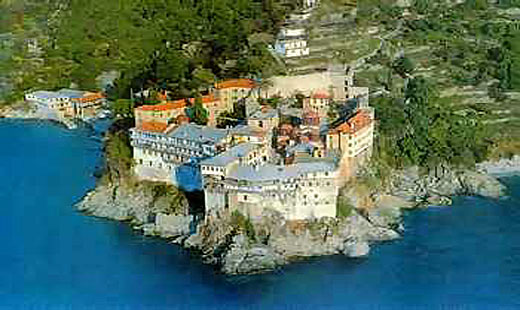
The construction of monumental buildings and harbors had shocked some of the old-fashioned hermits, the most prominent of which was Pavlos Xeropotaminos, who perceived the ascetic life as an escape to the wilderness, total solitude and complete withdrawal from secular life. They accused Athanasios of bringing the outside world into the Mountain and protested to the Byzantine Emperor Ioannis Tsimiskis. Through his representative Euthymios the emperor not only did not uphold the accusations but recognized and confirmed the rights of the big monasteries. The rules and disciplines of Athanasios were formulated in the first Typikon (Charter) in 971 AD and this document still governs life on Athos today. It was written on a goat skin and for that reason it was called Tragos (Billy-goat).
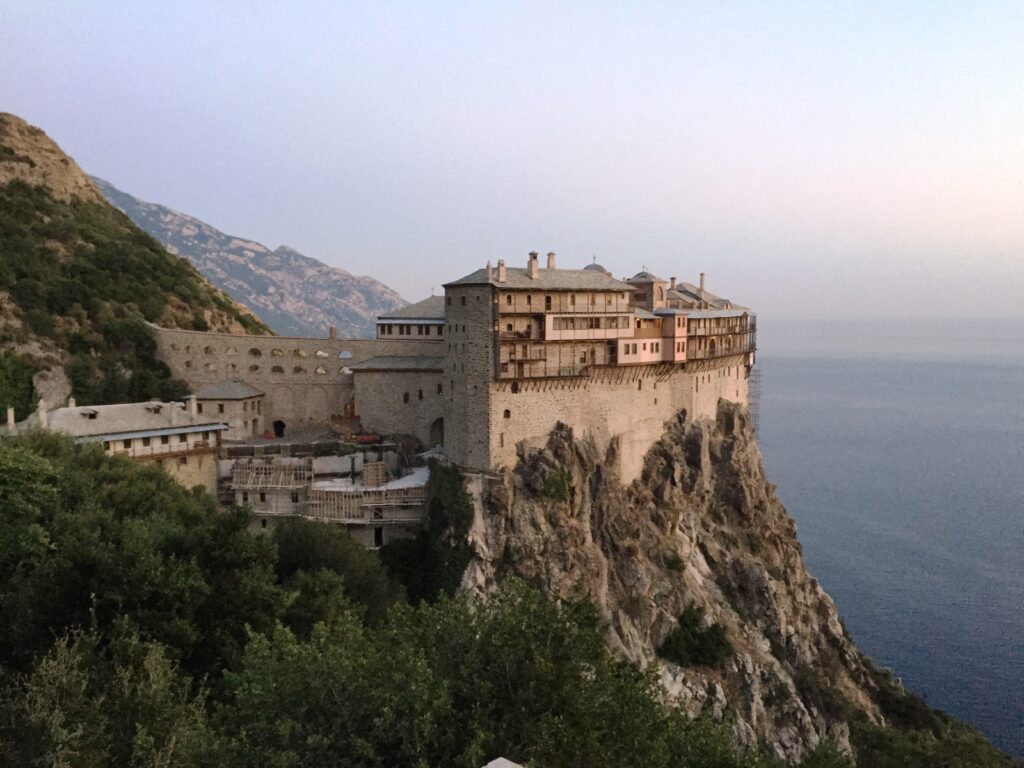
By the eleventh century the number of monasteries increased greatly, some say to 180. However, from the end of that century frequent pirate raids took their toll and drastically reduced their numbers. During the thirteenth century the Latins occupied Mount Athos and the monks were subjected not only to frequent raids but also to great pressure to accept the unification of the two churches. It was one of the darkest periods of Mount Athos and many monks were tortured and executed. This pressure eased during the reign of Andronikos the IInd who provided the funds for the monks to restore their properties. More pirate raids and pillaging by Catalan mercenaries reduced the number of monasteries to twenty five. Successive Byzantine Emperors and even Serbian rulers provided donations which helped Mount Athos to return to its former glory. Indeed many of the Emperors sought refuge in the solitude of the Mountain and spend their old age there under the anonymity of the black monastic cloth.
The fifteenth century was by far the most peaceful period for the Mountain. This peace was broken by the fall of Constantinople in 1453 which brought Mount Athos under Turkish occupation that lasted for the next 400 years. However, Sultans Murat the IInd and Mohammed the IInd, issued firmans (Turkish Edicts) recognising the rights of the monasteries and Mount Athos as “the country in which day and night the name of God is revered …. a refuge for the needy and for travellers”. During this period – 17th and 18th centuries – Mount Athos became a centre for the development and preservation of Greek culture and heritage. An Athonite Academy was founded close to the monastery of Vatopedi, which produced such illustrious pupils as Kosmas Aitolos, Athanasios Parios and Tzertzoulas. Also the monk Kosmas Lavriotis established a Greek printing press at Lavra, which contributed to the spread of books among the enslaved Greek people. All this ended with the outbreak of the war of independence in 1821, which the monks supported wholeheartedly and helped, even fought in it, until the eventual liberation. The last century brought another up-turn in the fortunes of Mount Athos with a large influx of monks from Orthodox Bulgaria, Rumania and especially Russia.
Today there are 20 monasteries of which 17 are Greek, one Russian, one Serbian, and one Bulgarian. There are also twelve Skites (similar to monasteries but much smaller), a large number of Kellia (large farm houses), Kalyves (smaller houses), Kathismata (small houses for a single monk) and Hesychasteria (hermitages or caves in desolate cliff faces, for the most austere hermits). The constitution of Mount Athos is traditional, based on seven Typika (decrees) dating from 971 to 1810 and ratified by the Treaty of Lasagne in 1923. Each monastery is autonomous and is led by the Igoumenos (Abbot), helped by a committee. The Skites, Kellia etc are usually dependencies of a monastery. The legislative authority is the Holy Assembly which consists of the 20 Abbots of the monasteries.
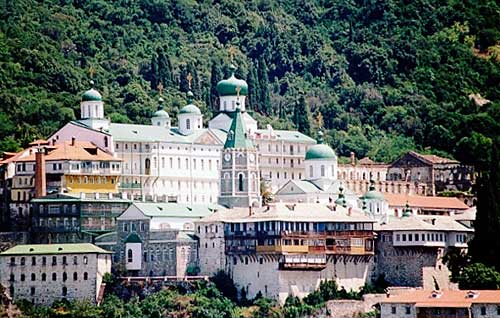
They meet at Karyes twice a year to ratify legislative decisions relating to the monastic life. The administrative authority is exercised by the Holy Community, twenty elected members, one from each monastery. They are appointed on the 1st of January for one year and live at Karyes, the capital. The executive authority is exercised by the Holy Epistasia a committee of four representatives. The monasteries are divided into five groups of four monasteries. On the 1st of June each monastery in a group appoints a representative who takes his place in the Holy Epistasia for a year. The next year another group of monasteries provides the representatives so that each monastery is represented once every five years. Although the four representatives are equal in rank, the one from the senior monastery in the group is appointed Protos (leader). Great Lavra, Vatopedi, Iviron, Hilandari, and Dionysiou are considered the senior monasteries in Mount Athos.
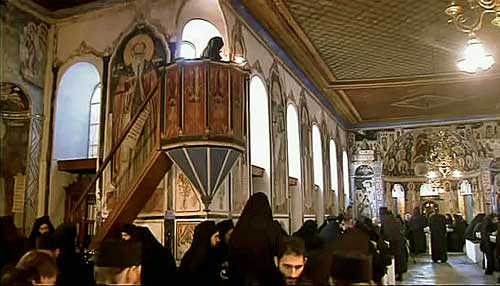
The world of Mount Athos is a different world, full of mysticism and religious contemplation. The daily lives and religious practices of the monks are according to strict Byzantine rules, stated in the Typikon and unaltered throughout the centuries. The moment one steps his foot on the Holy Mountain he finds himself back in time, literally. The Julian calendar is still being used so the date is fourteen days behind the rest of the world. Which means that Christmas is celebrated fourteen days late. At sunrise the clocks point to one o’clock and at sunset to twelve o’clock.
When someone enters Mount Athos with the view to taking the vows he usually chooses a monastery and presents himself to the Committee. The applicant must not be less than eighteen years old, he must belong to the Orthodox Church, and must be applying in his own free will. Foreigners automatically acquire the right of residence and Greek nationality. If he is accepted he is appointed to some humble post such as kitchen help or helping to cultivate the land. The initiation period which usually lasts for three years is to test the new recruits strength of faith, resilience and suitability. Taking the vows is not a decision to be taken lightly and the Dokimos (on test) has to be certain. From the moment he is ordained as a monk his entire life is dedicated to the quest of reaching for god, a life of continuous prayer and contemplation. Only when the new recruit feels ready and the Abbot agrees he is ordained and is allowed to wear the monastic gown and hat.
The ceremony is a joyous and moving occasion, akin to baptism. The officiating priest in his regalia invites the Dokimos (on test) into the church. The future monk enters, without his habit and monastic hat, and kneels at the altar before the Igoumenos (Abbot), to the sounds of the chanting choir and the ringing of the church bells. First the priest offers thanks for his rescue from a world full of sin. Then in a series of question and answers between abbot, priest and himself kneeling, the novice confirms repeatedly that he is taking the vows in his own free will. He confirms that he intends to continue in the monastic state and to abide by the rules of the monastery by taking the vows of stability, obedience, poverty and chastity. To emphasize his desire to enter the monastic life he offers the ceremonial pair of scissors to the priest. The officiating priest cuts a few hair crosswise from the novice’s head, in the name of the Trinity, and covers the shorn head with the monastic hat, draping the black monastic cloak over his shoulders to the joyous sounds of the choir. He has just become a monk of the Little Habit. If he ever feels the need for advancement, for more prayer and solitude, he could take the next step and enter the Greater Habit.
He has now died to the outside world and has been re-born into the holy world of Mount Athos. He gives up his past life, his name, his status and property. He takes up the name of one of the saints with the same initial as his original name. Instead of a surname he uses the name of the monastery where he lives. All monasteries are now Coenoveatic (communal) so he is given a sparse room and habits to wear. He is also appointed to a particular job, when he is not in church. To exit Mount Athos he needs the permission of the Igoumenos (Abbot). Following their ordination many monks have never visited the secular outside world.
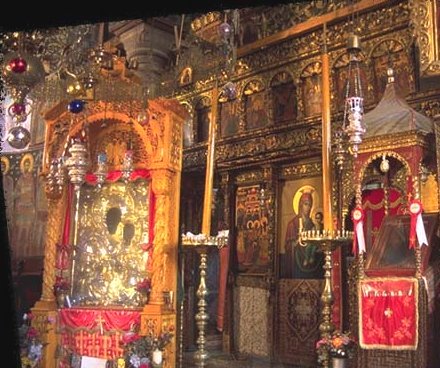
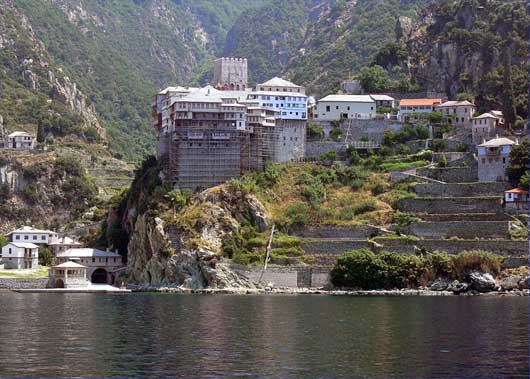
The life of the monk is divided into three equal parts, one for praying, one for working and one for resting. He is waken by the repetitive beat of the symantron ( a long wooden symbol hit by a mallet ) at 11 p.m. for an hour of private prayer. Counting the knots of the rosary he repeats the Kyrie Eleison “Lord Jesus Christ, have mercy on me”. Then back to sleep until 4 a.m. when the sounds of the symantron fill the courtyards and the dark corridors once more, inviting everybody to the church for matins and the chanting of the hours. The Liturgy follows, timed to be celebrated at sun-rise, when the gates of the monastery are opened. At the end of the Liturgy, at about 10.30 a.m., the Igoumenos (Abbot) leads his monks to the refectory for the main meal of the day and from there everybody goes to their allotted tasks. One more service is celebrated in the church during the afternoon, depending on the time of year either at 3 p.m. for nones or at 5 p.m. for vespers. After vespers there is the supper at 7 p.m. and then the monk is free to retire. On certain occasions a vigil is celebrated which calls for a continuous service throughout the evening, night and the following morning.
The monks have two main meals a day, one at half past ten in the morning and supper at about seven in the evening. Meals are taken in the richly adorned refectory, while a reader on a pulpit reads from the New Testament throughout the meal. The food is basic: a seasonal salad, baked beans or lentils cooked in plenty of water like soup, a dish made of all the seasonal vegetables cooked together in one pot, salted fish, olives, fetta cheese, brown bread, fried potatoes and always the delicious local red wine. At festivals fish is served but never meat. The Igoumenos (Abbot) sits at the top table and marks the start and the end of the meal with the ringing of a bell and a prayer. A single meal without oil is eaten at noon on Mondays, Wednesdays and Fridays. Neither meat, fish, cheese, butter, nor eggs are permitted during the forty days of Lent ending in Easter. The most reverent monks eat nothing during the last days of the fast. A similar abstinence takes place during the Lent of the Apostles Peter and Paul, (from Monday after All Saints Day to June 28), during the fourteen day Lent of the Mother of God, (from the 1st of August to the 14th) and during the Christmas Lent, beginning on 15th of November and ending on the night of Christmas Eve.

After entry the pilgrims are free to visit any monastery they wish. The monasteries uphold a long tradition of hospitality for those who need Mount Athos, those who seek solace, relief from the troubles of the outside world or those who are on a pilgrimage. Food and a bed to sleep are provided entirely free, although the conditions are basic and visitors are expected to conduct themselves according to certain standards. Much of the travelling is done either by boat or on foot for the roads are narrow and winding dirt-tracks.
As the pilgrims approach each monastery they cannot fail to be moved by the stunning natural scenery and the imposing architecture. The monasteries are fortified Byzantine castles with monumental walls all around and a courtyard in the centre. Others look like unassailable towers. The monastery of Simonos Petras (above) is a good example. It is perched on a large bolder a testimony of glorious times past. There are many architectural styles, enough to keep an architectural historian busy for the rest of his life. The monastery of St Panteleimon (left) is a good example. It was built by monks who came from Russia, hence it is called Rossiko, and the style clearly reflects the Russian influence. Successive Tsars bestowed it with wealth and treasures which made it one of the largest and richest monasteries in Mount Athos.
The entrance to a monastery is through two large, fortified gates, one on the outside and one on the inside of the outer wall. There the pilgrims meet the gate-keeper, a monk whose job to close the doors at sunset and open them again at sun-rise. He checks the permits and leads them to the Arhondariki (the reception room). The Arhondaris (guest master) offers all pilgrims the traditional welcome, a Loukoumi (Turkish delight), a glass of raki (home made Ouzo), a cup of Greek coffee and a glass of cool Athos water. The experienced guest eats the Turkish delight in one, tosses the raki down, and sips the coffee at leisure. Then pilgrims are led to their rooms to rest. At approximately four o’clock the hollow beat of the symantron invites everybody to the church for vespers. After vespers the Igoumenos (Abbot) leads everybody to the refectory for the evening meal, while a reader reads from the pulpit. Non Orthodox visitors may be asked to eat in a separate room. When the Igoumenos (Abbot) declares the end of the meal by ringing a bell and a short Eucharist, the pilgrims are taken to the main church in order to pay their respects to the miraculous icons and the Holy Remains which are part of the heritage of each monastery. Some sightseeing is excused but the visitor must always remember that he is considered by the monks to be a pilgrim, not a tourist. The monks are quite happy to answer all questions, to show the treasures, the ancient icons, the wall murals, the golden Holy Artifacts, as long as the intention is to venerate, not to simply admire them. Do not hold your hands behind your back as if on a sight-seeing tour, hold them in front of you in a sign of reverence.
The rest of the evening is free but monks retire early. Ask to be awaken for the 4 a.m. matins which is a truly unique experience. To the sound of the symantron everybody enters the main church which is dimly lit by a few candles and the oil lamps in front of the icons. The monks are dark shadows, shuffling to their usual seats. The chanting is out of this world and the myrrh sweetens the air adding to the mysticism of the occasion. The soul is uplifted and the visitor realizes the true beauty of Mount Athos, a beauty which can bring you so close to heaven.
An ancient law exist which forbids a “road upon which a wheel can run” to be built between Karyes and the rest of the world. Mount Athos treasures its isolation and is only accessible by boat. The basic conditions for admission are defined in a Chrysobullo (edict) which was issued by the Byzantine Emperor Constantine Monomahos, in 1060 AD It is still valid and decrees that: (a) Women are never admitted into Mount Athos, (b) a permit is required for anyone entering the territory and (c) overnight stay is forbidden except for those who have proven religious or scientific interests and are over 18 years old.
The procedure to obtain the appropriate permit is complicated and lengthy, especially for non Orthodox visitors. There is a daily quota of 120 Orthodox pilgrims and 10 non Orthodox. Orthodox Greeks can apply by producing their identity card at the Athos Bureau in Ouranoupolis. Non Orthodox pilgrims have to establish a valid reason for visiting Mount Athos, by producing a letter of recommendation from their embassy or an academic institution. They must also explain in another letter the reason for their proposed visit. Sightseeing or tourism are not valid reasons. Pilgrimage or study are. The two letters and passport have to be submitted a least a month ahead of the proposed date of the visit to the Ministry of Foreign Affairs, Directorate of Churches in Athens, or to the Ministry of Northern Greece, Directorate of Civil Affairs in Thessaloniki. An authorization is issued which should be presented to the Athos Bureau in Ouranoupolis a day before the visit where the Diamonitirion (permit) is produced, specifying the date of entry. The maximum stay permitted is four days. The ship sails the next day from the jetty by the Byzantine tower.
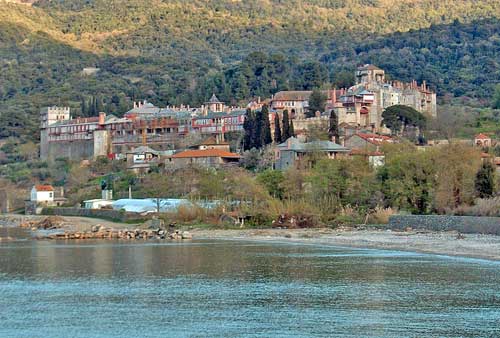
Inside the monasteries and the numerous churches there is an unimaginable wealth of unique treasures; religious frescoes decorate every wall, rare mosaics, libraries stacked with ancient publications and Imperial Chrysobulls (Edicts), ancient icons many of them adorned in gold, many of them miraculous, precious art miniatures, ecclesiastical artifacts covered in gold and precious stones, the presents from pious Byzantine Emperors. The Holy remains of many saints, and the largest piece of the Holy Cross. For Mount Athos has preserved the largest collection of Christian art in the world, a rich heritage amassed over many centuries, the donations of successive Byzantine, Russian and Slav emperors. They are unique works of art and each monastery is proud of its own heritage.
The earliest murals on Mount Athos are from the 12th century. They are found at the monastery of Vatopedi and show the Apostles Peter and Paul. At Karyes, the capital and seat of the administrative assembly stands the church of Protato, the oldest on the Mountain ( 10th century). It is without doubt one of the most important churches on Mount Athos for its ancient walls are adorned with frescoes (right) painted by Emmanuel Panselinos, the last of the great mural painters from the Macedonian School of Art (14th century). His work can be found in many other churches on Mount Athos. Murals of this school of art as well as murals of the Cretan School of Art which flourished later (16th century) decorate the churches in the monasteries of Agia Lavra, Vatopedi, Iviron, Koutloumousiou and Doheiariou. Equally important murals but dating from the 18th century can be found in the monasteries of Xenophondos, Grigoriou, Pandocratoros, Philotheou, Karakalou, Xeropotamou and Esfigmenou.
Icons are an integral part of the Orthodox Christian belief and tradition. Mount Athos developed an icon painting industry at an early age which is thriving even today. The earliest icons are from the 10th century. There must be close to 18,000 icons on the Mountain today and their styles span the centuries, from the austere Byzantine to the more decadent Renaissance. Many of them are thought to have performed miracles, particularly those of the Virgin Mary.
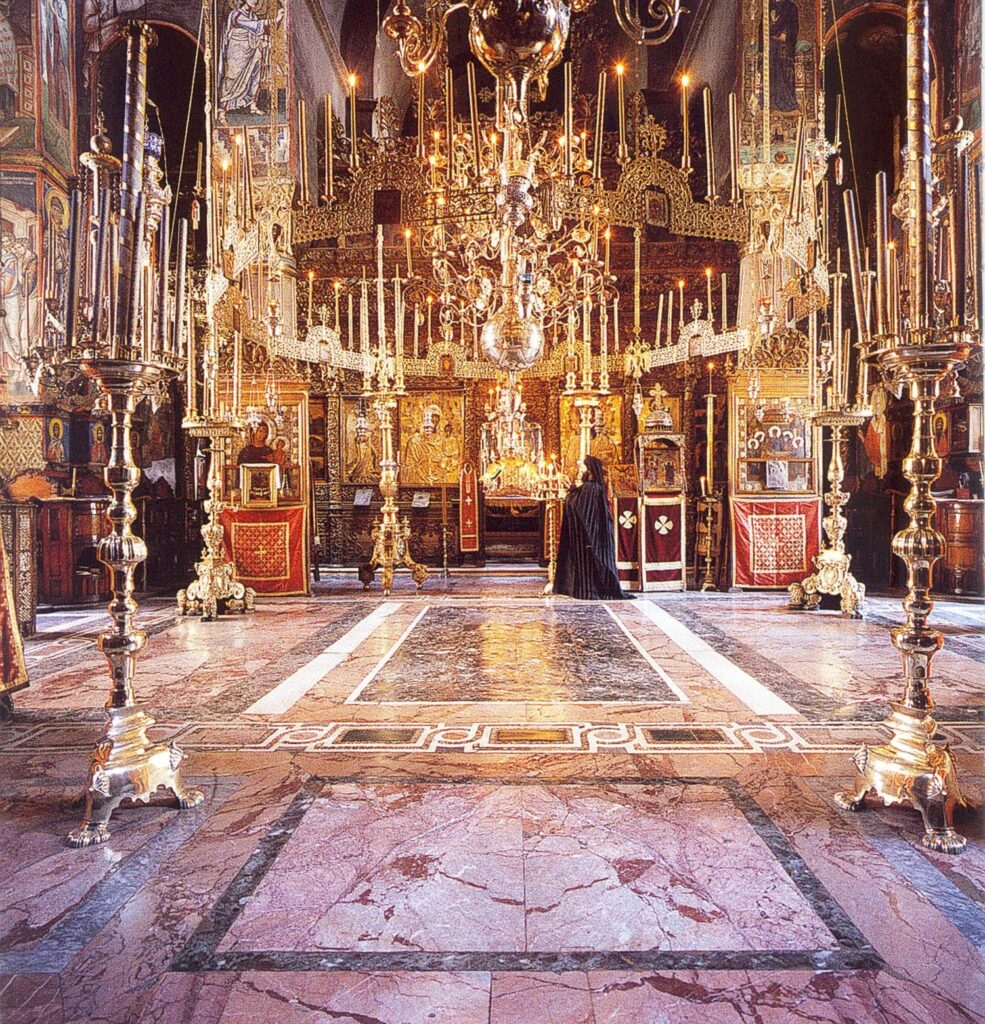
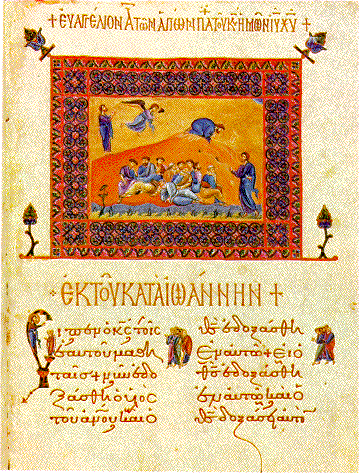
Another tradition closely associated with Mount Athos is that of calligraphy. The original Typicon (constitution) ordained that a calligrapher should be resident at the Monastery of Great Lavra and a printing press existed during the Turkish occupation. Most monasteries maintain large libraries which are real treasure-chests of knowledge. One of the better known libraries is that of Philotheou. Although fires, pirate raids and the Turkish occupation took their toll on the collections, an enormous amount of books and manuscripts survive, such as the first Typikon (charter) from 971 AD which is written on a goat skin. Rare books, beautifully illuminated manuscripts and unique Chrysobulls (imperial decrees) signed by the hand of Byzantine Emperors, are reverently preserved for posterity and form an integral part of the inheritance of each monastery.
The beauty of Mount Athos is in its timelessness. It is as if the monastic part of the Byzantine world has been preserved in this quiet, full of mysticism corner of the world. It is not only a living museum, but principally it is a place for prayer and contemplation, free from external influences. There, the monastic ideals and way of life have been preserved in their purest form. Privileged are those who have been able to visit for a pilgrimage there.
